September 24, 2020
From the Vault: A Prudence Island Clam Bake, Part I
A very short article in the Bristol Phoenix leads us to consider a very specific moment in time (and spend a lot more time digging in the archives)
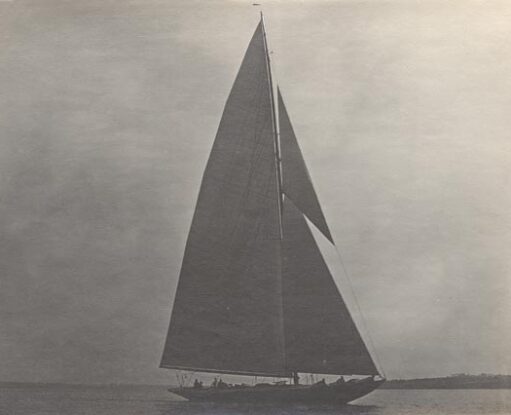
Introduction
Every day, archives both privately and publicly held are being made increasingly available to the public online. From our perspective at HMM, this is particularly exciting because many pieces of the HMCo. legacy are physically held in different locations and collections, both public and private. Digital access to other collections has afforded us the opportunity to bring together elements of a story that have been separated for more than a hundred years in some cases. The wave of recent digitization helps us tell these stories with more context than ever. The incredible work and generosity of researchers and institutions holding and interpreting this legacy - like the Herreshoff Catalog Raisonné, the MIT Museum's Haffenreffer-Herreshoff Collection, Historic New England's Stebbins collection, the Library of Congress digital archives, the Bristol Phoenix and so many others - have allowed us to bring you so many of these Code Flag Lima stories. In fact, there isn't a single Lima post that has not relied on the work of others in some way. While drawing these threads from different collections together is an evolving, never-ending project, the process of digital reassembly and subsequent discovery is one that brings the real HMCo. fanatics among us a great deal of satisfaction and delight. We hope to share some of that delight with you today as we assemble a few pieces of the archive and reconstruct a vignette of a particular day, showcasing some of these collections we have come to appreciate and rely on so very much.

A Clam Bake for Yachtsmen
A short and unassuming article appeared in the Bristol Phoenix on September 16, 1919, describing the following: "a clam bake, made under the direction of Col. A. W. Hathaway, at the Maytum place, Prudence Island, Sunday, was enjoyed by a party of 35, which included Robert W. Emmons, 2nd, Charles Francis Adams, 2nd, R. N. Ellis, George Parkinson, and other members of the New York Yacht Club, besides superintendents, foremen and clerks of the Herreshoff Manufacturing Company. The yachtsmen are in Bristol to witness the trials of a new "Marconi rig" on the sloop yacht Carolina, which have been held in the bay during the past few days."
So, what? We dig into all of the archives (including our own!) to shed a little light.
Who was Col. A. W. Hathaway?

Col. Asa W. Hathaway was a significant figure at HMCo. from the 1890s through the early 1920s. He was an HMCo. foreman and HMCo.'s lead sailmaker through the Cup Defender years. Apparently a man of many talents and not a little leadership prowess, was also Chief Engineer of the Fire Department and manager of the Herreshoff Orchestra. Correspondence suggests he was senior enough in his role at HMCo. that he interacted personally with America's Cup syndicate heads alongside N.G.H. when necessary. He certainly would have to have been a person of high regard to have been trusted to host the clambake described above, and would likely have known quite a few of the yachtsmen in attendance from being onboard vessels or on hand for trials in which his work as a sailmaker was tested. Hathaway left HMCo. in 1921 before the second sale of the company to the Haffenreffer family in 1924, at a time when HMCo.'s future was looking rather uncertain. After leaving HMCo., Hathaway joined in business with Alden Reiser, a sailmaker originally from Lunenberg, Nova Scotia. The business would eventually become Hathaway, Reiser and Raymond.
Picnicking on Prudence
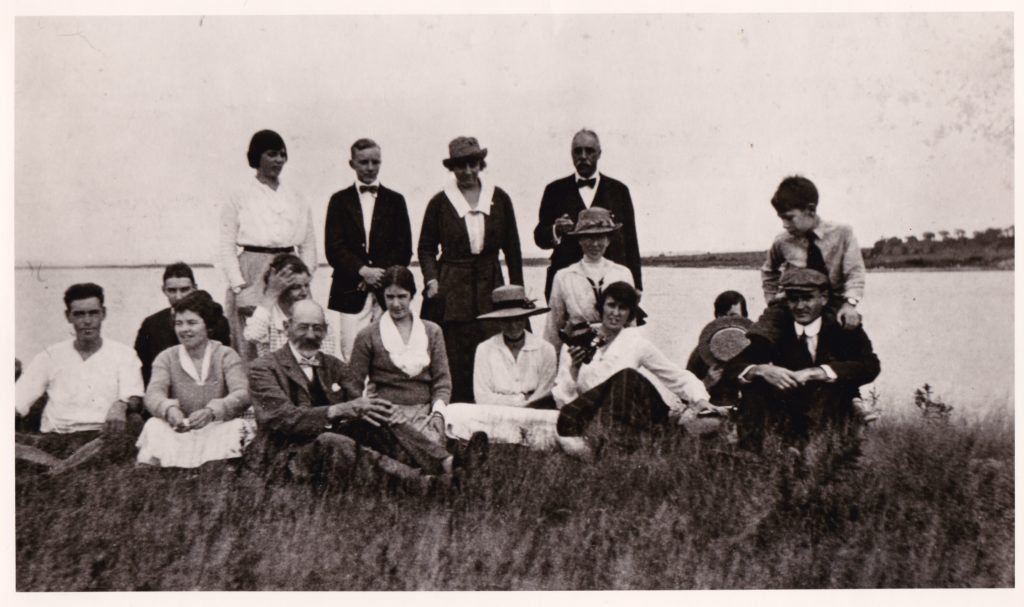
Prudence Island is the third largest island in Narragansett Bay. It was primarily a farming community until the 1870s, when investors began building summer homes on the island and regular ferry service was established. Not unlike Rocky Point, it was a popular excursion destination in the early 20th century, with numerous mentions of family vacations and group outings and excursions appearing over and over again in the Bristol Phoenix. The island (virtually bald!, as much of New England was at the time) appears as the backdrop in many Herreshoff family photo albums, such as this photo from a family picnic in 1918 (right), or this June 1919 photo of NGH's COQUINA (HMCo. #404) with three passengers aboard under sail (below). Again judging by the numerous mentions in the Phoenix, Prudence Island was not only a place for vacationing, but also a popular destination for professional group excursions.
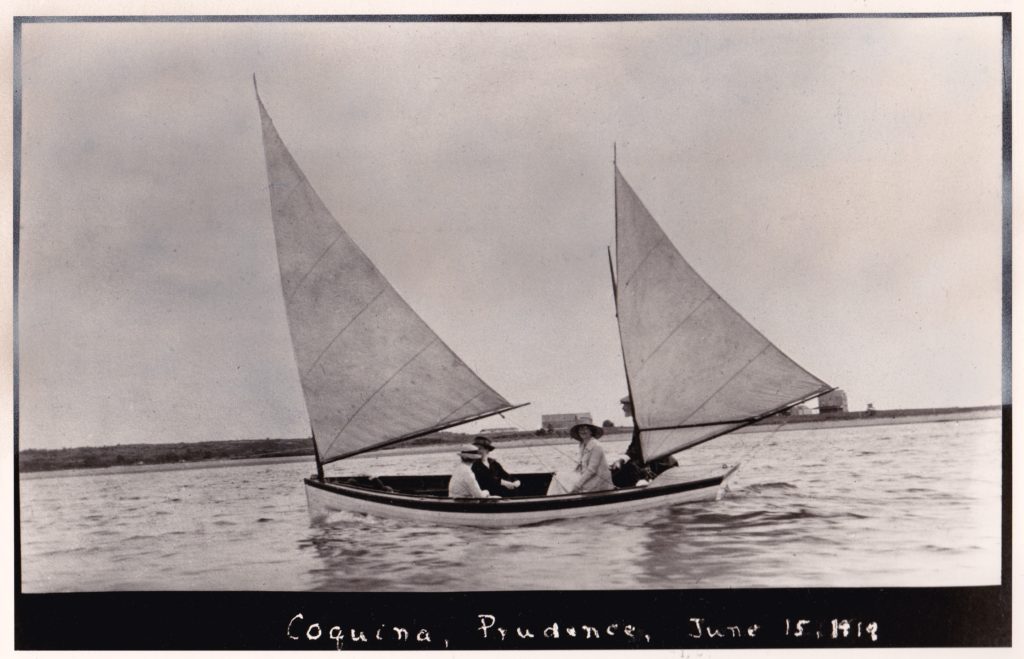
The Party of 35
Who was in this party? This was a group of eminent, wealthy New York Yacht Club members were the who's who of the yachting scene at the time. Not only that, but they were accompanied by a number of management-level employees from HMCo., on a Sunday to boot. Clearly these were important past and hopefully future clients that HMCo. cared a great deal about... but they were not just potential customers. Remember, this was not HMCo. in its heyday, it was a time when the Company was struggling from a business perspective. Not only were they still trying to stabilize the Company financially following J.B.H.'s death in 1915, but WWI was only eleven months gone. HMCo. was about to experience a post-war slump despite the preceding windfall of wartime contracts. Robert Emmons and Charles Francis Adams (both noted in attendance in the Phoenix piece) were actually both members of the group of stockholders - mostly RESOLUTE (HMCo. #725) syndicate members - that had invested in HMCo. in 1917 to keep the company afloat. They were not just HMCo. boat owners - the party included Company owners.
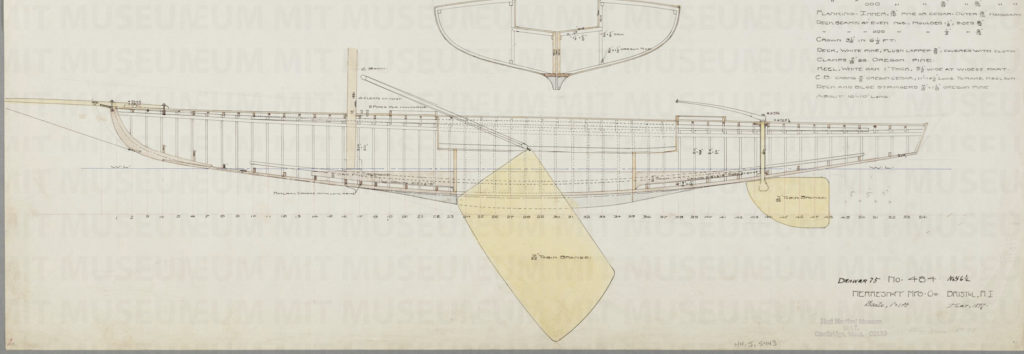
Robert Emmons is a character of particular interest to us in this party. Emmons, like Hathaway, was another person we don't hear enough of today in relation to HMCo. He was enormously important in the Company's history however, and continues to impact the Herreshoff legacy. He was an extraordinarily faithful customer, commissioning more than 25 HMCo. vessels between 1897 and 1915, and was a close correspondent of N.G.H.'s. He was extremely involved with the production of a huge range of HMCo. vessels, from the Cup Defender RESOLUTE as a syndicate member all the way down to the ubiquitous Buzzards Bay 15s and Buzzards Bay 12 1/2s. His relationship to HMCo. in the early 1900s through the 1920s is one that bears further investigation to fully understand its significance, and there is still much to be learned from the archive where he is concerned.
The "Marconi Rig"
Today the Bermudian or Marconi rig (as opposed to gaff rig) is everywhere. But once, it was a novelty in New England - and that "once" for us was the fall of 1919. N.G.H. would have been familiar with the type from his winter vacations to Bermuda, but to see it demonstrated on the scale of CAROLINA (more on her below) would have been a sight, even for him. These towering masts with a single tall unbroken stretch of triangular sail were enabled by sail track hardware and wire stays that stabilized the extreme height of the mast. To gain that sort of sail area height previously, a gaff and topsail combination was necessary due to the obstruction of mast hoops by spreaders: mast hoops can't be raised past spreaders, therefore, you have to break up the sail and add extra spars if you want canvas above the height of your spreaders. Once the mast hoops could be eliminated thanks to the innovation of adding sail track and hardware that could run up the after end of the mast, sails were no longer limited in their height, within reason. The "Marconi rig" was so-nicknamed for the sky-high radio towers popping up around the world in the early 1900s. With their guy-wire-like stays and incredible height, it was said that these new rigs (named for their inventor, Guglielmo Marconi) resembled the towering structures then appearing on the horizon in New England.
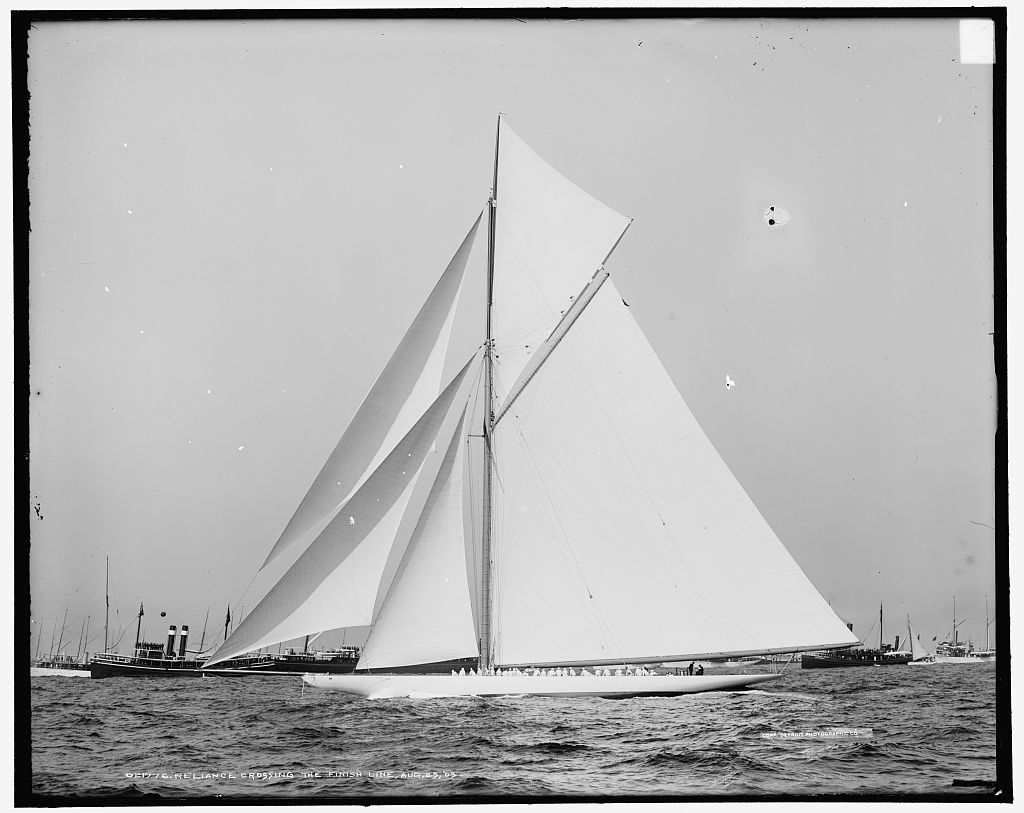
RELIANCE (HMCo. #605) did not carry a Marconi rig. She is a colossal example of a gaff rigged cutter - compare her to the images of CAROLINA below; image courtesy the Library of Congress 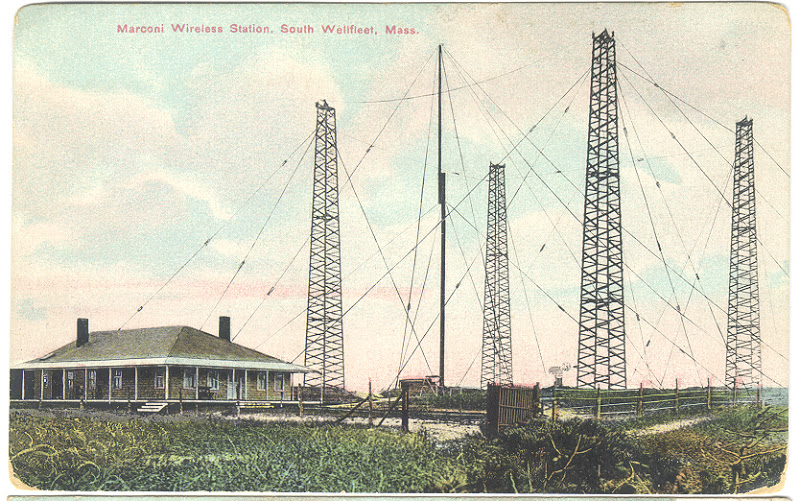
The Marconi radio station on Cape Cod, also built in 1903; image courtesy the New England Historical Society
CAROLINA II (HMCo. #721)

So, demonstrating this new rig was evidently a momentous enough occasion to invite investors and owners of the company as well as other eminent possible clients to witness. What the Phoenix doesn't mention is that this was not just a low-stakes solo performance. CAROLINA II (HMCo. #721) was being trialed against GRAYLING (HMCo. #715), her still-gaff-rigged older sister from the 1913 class of New York 50s. This one-design class of titans was designed by N.G.H. in September of 1912, and ten were built in total between 1912 and 1915. This was the largest (in terms of WL, not total numbers) successfully competitive one-design class N.G.H. ever designed and HMCo. built, for some of the most competitive yachtsmen in the world.* If they were going to be convinced a Marconi rig would provide them with a competitive advantage, they would need proof.
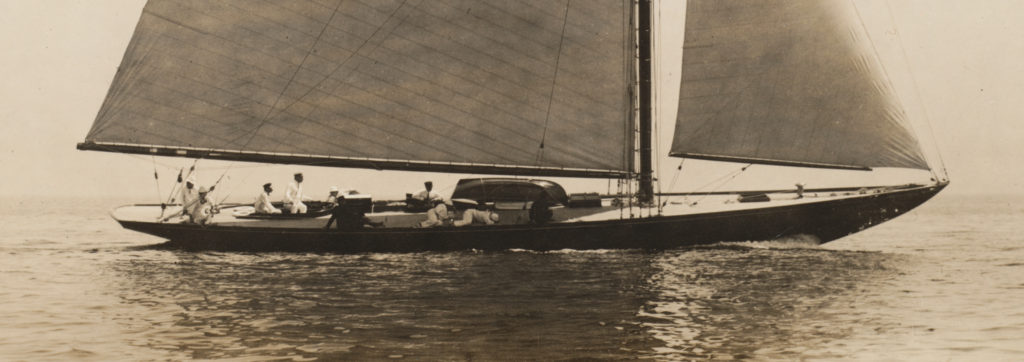

GRAYLING, sporting her traditional gaff rig in 1913; image courtesy the Stebbins Photographic Collection, Historic New England 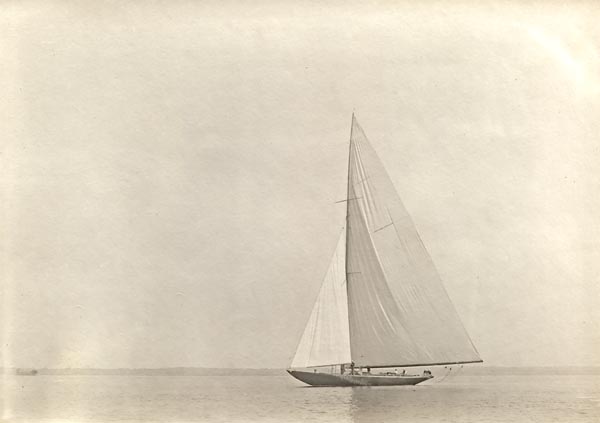
CAROLINA II, with her Marconi rig; image from the HMM photo collection 
CAROLINA II with her new Marconi rig, looking a little more convincing than in the shot above; image from the HMM photo archive
So did the clam bake plan work!? Were there other ulterior motives? Tune in next week for even more archival digging!
*At this point, the NYYC still hadn't lost the Cup, and the NY70s aren't usually considered to be a competitive "success."
